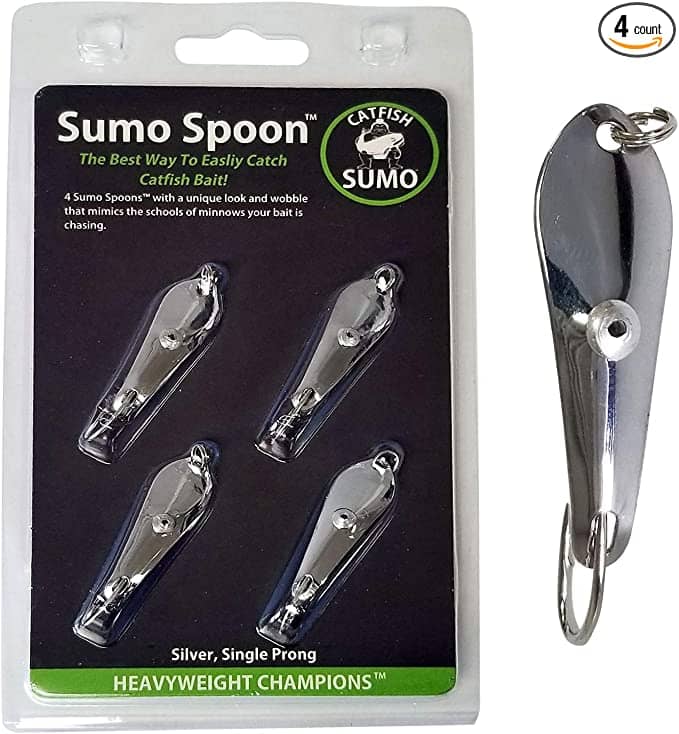Spoons fishing is a popular fishing technique that involves using a metal lure shaped like a spoon to catch fish. The spoon is designed to mimic the movement of a small bait fish, and is usually cast out into the water and retrieved in a way that creates a flashing, wobbling action that attracts fish.
Spoons come in a variety of sizes, colors, and styles, and can be used to catch a wide range of freshwater and saltwater fish species. This method is commonly used in trolling, jigging, and casting applications, and is often considered one of the most effective and versatile forms of fishing.
How to fishing with spoon?
Fishing with a spoon lure is a popular and effective technique that can be used to catch a variety of freshwater and saltwater fish species. To begin, you’ll need to select the right size and weight spoon for the fish you’re targeting and the fishing technique you’ll be using. Once you have your spoon tied to your fishing line, you can cast it out into the water and let it sink to your desired depth. Then, retrieve the spoon by reeling in your fishing line with a steady and consistent motion, while varying the speed of your retrieve to create a natural-looking wobble or flutter that mimics the movement of a baitfish. You can also try jigging or trolling with a spoon, which involves using different motions and speeds to create a more enticing presentation for fish. With some practice and experimentation, you can become a skilled spoon fisherman and increase your chances of catching the fish of your dreams.
Advantages of Spoon Fishing:
- Versatility: Spoons can be used in a variety of fishing techniques such as trolling, jigging, and casting.
- Effective: The wobbling and flashing motion of the spoon mimics a small bait fish, which can attract a wide range of fish species.
- Durable: Spoons are typically made of metal, making them more resistant to damage than soft plastic lures.
- Long casting distance: The weight of the spoon allows it to be cast further than some other types of lures.
- Cost-effective: Spoons are generally affordable and can last for a long time, making them a cost-effective choice for anglers.
Disadvantages of Spoon Fishing:
- Limited action: Compared to soft plastic lures, spoons have a limited range of motion and may not be as effective in certain fishing conditions.
- Heavy weight: The weight of the spoon can make it difficult to use in certain fishing techniques, such as fly-fishing.
- Snagging: The shape and weight of the spoon can increase the likelihood of snagging on rocks or underwater obstacles.
- Limited visibility: Spoons are not as visible as some other types of lures, which may make them less effective in murky or deep waters.
- Limited scent: Spoons do not emit scent, which may make them less effective for species that rely heavily on smell to locate prey.
When choosing a spoon for fishing, there are several factors to consider, including the fish species you’re targeting, the water conditions, and the fishing technique you’ll be using. Here are some tips to help you choose the right spoon:
- Consider the size and weight of the spoon: The size and weight of the spoon you choose should match the fish species you’re targeting and the fishing technique you’re using. Larger spoons are typically used for larger fish species, while smaller spoons are used for smaller fish. Lighter spoons are easier to cast, while heavier spoons can be used to reach deeper waters.
- Choose the right color: The color of the spoon you choose should match the water conditions and the fish species you’re targeting. In clear water, use a spoon that matches the color of the bait fish in the area. In murky water, use a bright or fluorescent-colored spoon to increase visibility.
- Pay attention to the spoon’s action: The action of the spoon should mimic the movement of the bait fish in the area. Look for spoons with a natural-looking wobble or flutter, and try to match the speed of the retrieve to the natural speed of the bait fish.
- Check the quality: The quality of the spoon you choose can impact its durability and effectiveness. Look for spoons made from high-quality materials that can withstand the rigors of fishing.
- Consider the fishing technique: Different fishing techniques may require different types of spoons. For example, trolling spoons may be larger and heavier than casting spoons, while jigging spoons may have a more vertical drop.
By considering these factors, you can choose the right spoon for your fishing needs and increase your chances of success on the water.

Sumo Spoon – Catfishing Bait Spoon
Unique weight and wobble mimics the schools of minnows your bait is chasing down. The Sumo Spoon’s unique second prong helps keep the fish hooked until you get it in the cooler.
What We Like
- Great lures for a great price.
- Good Price
- Sharp hooks
What we don’t like
- Little spoon

PROBEROS Fishing Spoons
Proberos Fishing Spoons Lures are Unmatched in Quality and Durability-High Performance Ainc Alloy Material, Which Offers Durable and Reusable Fishing Lures
What We Like
- Excellent value.
- Good size
What we don’t like
- Price





test